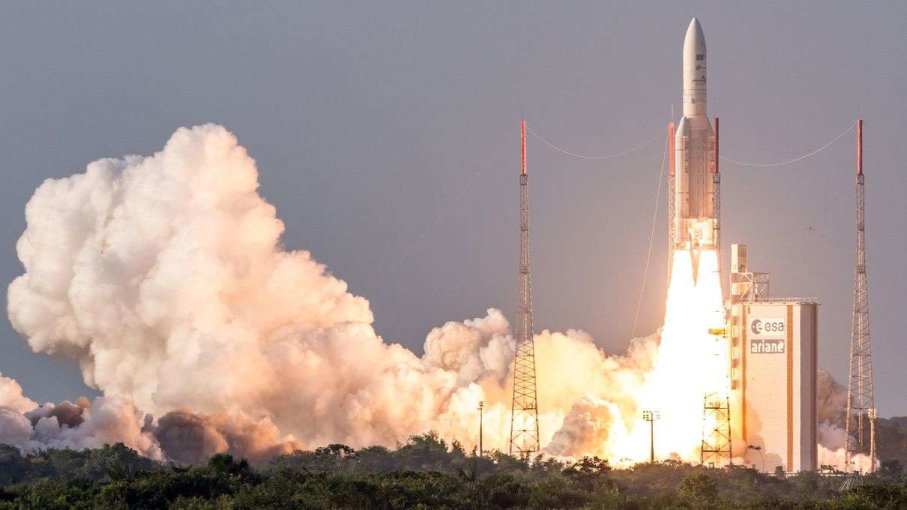Why the Next Few Years Will Be a Boom Time for the Private Space Race

In late November 2015 from a launch pad in West Texas, Amazon founder Jeff Bezos’ space startup Blue Origin successfully launched a reusable rocket called New Shepard into suborbital space. After reaching an altitude of nearly 330,000 feet above the Earth’s surface, where it released its payload, a capsule designed to carry human passengers in the future. Then the rocket descended back down, braving a 119-miles-per-hour high-altitude crosswind, and made a controlled robotic landing just four and a half feet away from the spot where it had been launched.
“We can’t wait to fuel up and fly again,” Bezos boasted on the company’s website.
It wasn’t the first time that a rocket had reached space and returned to Earth safety; as Bezos’ competitor, SpaceX founder Elon Musk, reminded him on Twitter, SpaceX’s experimental Grasshopper rocket had made a half-dozen suborbital flights back in 2012.
But even so, the impressive success of Blue Origin’s reusable rocket, and Spacex’s own Falcon-9 in December, provided another sign that the commercial space industry seems poised for dramatic growth in the next few years. In what some are calling Space Race 2.0, private businesses will transport passengers as well as cargo and satellites into the cosmos. The competition already is attracting a fast-growing number of competitors, ranging from Silicon Valley entrepreneurs such as Musk and Bezos to European and Asian government space agencies, which are joining forces with private companies.
Spending for the Stars
The private space industry is so hot that investors have committed an estimated $10 billion to it. That includes a $1 billion investment in January 2015 by Google and Fidelity Investments in SpaceX.
NASA has been counting on private space launch companies to take over jobs formerly handled by the Space Shuttle program, which ended in 2011. Since then, SpaceX’s Falcon-9 rocket and Dragon spacecraft have flown numerous unmanned cargo missions to the International Space Station. A June 2015 flight suffered a mishap and broke up in flight.
Nevertheless, NASA remains confident enough in SpaceX’s reliability that in November, the government space agency announced that SpaceX will transport astronauts to the ISS for the first time in late 2017.
But there’s plenty of room for other space-launch competitors, including Orbital ATK, which also has a NASA contract to resupply the ISS with its Cygnus spacecraft, and United Launch Alliance, a partnership between Lockheed Martin and Boeing that uses rockets such as the old-school Atlas V rockets to launch payloads by Orbital and others. Another big player, Virgin Galactic, is planning to build its own launch site in Long Beach, California.
Satellites in Orbit
Additionally, though, there’s also a surging demand for launches by private customers who want to put satellites into space. These private satellites could be used for everything from providing broadband Internet to shooting high-altitude images of farm fields to help with crop cultivation.
A report prepared for the Satellite Industry Association by the Tauri Group, a research firm that tracks the private space industry, predicted that global satellite sector alone will more than double in size by 2025, when it will generate $470 billion in revenues.
A lot of these satellites are pretty small, which creates an opportunity for private space launch companies who could transport bunches of them at once in their cargo holds. It’s a business that would become even more lucrative if they can use the same spacecraft over and over.
“While bulk procurement of big rockets is one of the options currently under pursuit, the major focus is towards achieving air-launched launch capabilities, potentially reusable in part or full,” says Arun Kumar Sampathkumar, a senior research analyst at the consulting firm of Frost & Sullivan, via email. “The idea is to skip the expensive solid-booster stage, so as to achieve the low costs that can allow the cheaper pricing for small-satellite operators.”
International Players
While we hear a lot about high-profile American players such as SpaceX and Blue Origin, Sampathkumar says that competition is increasing across the globe. Already, 35-year-old French company Arianespace owns a big slice of the global satellite business.
Full Width
Caption:Japan’s H-2A rocket, which carries the Himawari-8 weather satellite, leaves the launching pad at the Tanegashima Space Center, Kagoshima prefecture, in southwestern Japan
JIJI PRESS/GETTY IMAGES
And others are getting into the game as well. The UK government, for example, is seeking proposals for a spaceport in Scotland that could service private satellite and passenger flights by companies such as Virgin Galactic by 2018.
India, China and other Asian countries also have their own government space programs, and some are using them to help private space companies get a foothold as well, according to Sampathkumar. But Asian money also is flowing into U.S. space companies. According to Forbes, Chinese venture capital firm Haiyin Capital has invested $5 million in XCOR Aerospace, a California-based firm that is developing a two-seat reusable suborbital spaceplane.



 Creators of mankind
Creators of mankind Description of “Tall white aliens”
Description of “Tall white aliens” Where they came from?
Where they came from? About hostile civilizations
About hostile civilizations The war for the Earth
The war for the Earth “Tall white aliens” about eternal life
“Tall white aliens” about eternal life Video: “Nordic aliens”
Video: “Nordic aliens” Aliens
Aliens Alien encounters
Alien encounters The aliens base
The aliens base UFO
UFO Technology UFO
Technology UFO Underground civilization
Underground civilization Ancient alien artifacts
Ancient alien artifacts Military and UFO
Military and UFO Mysteries and hypotheses
Mysteries and hypotheses Scientific facts
Scientific facts


















